________________
4. JAINISI IN KARNATAKA
125 Samgha, Dēsi gana and Pustaka gachha, claim their descent in the line of pontiffs founded at Sravana Belgola by Chārukirti Pandita sonjewhere by the beginning the 12th century A. D. Srutakirti, a preceptor of Chāru. kirti's line, came to Hāļuvalli or Sangitapura in the Bhatka! Pēțhā and established a pontifical scat some time by the carly part of the 15th century A. D. The succession of these preceptors was hence known as the Sangitapura line. An inscription in the Ratnatraya Basadi' at Bīligi gives the pedigree of these teachers as follows: Srutakirti (I), Vijayakirti (1), Srutakirti (II), Vijayakirti (II), bis two pupils: Akalanka (I), and Chandraprabha; Akularka (1) had three generations of pupils : Vijayakirti (III), Akalanka (II) and Bhattākaļanka.
The earliest date available for Bhattākalauka, the last member, in another inscription from the same temple at Bilīgi, is Saka 1510 (A.Do 1583). Starting on this basis and calculating at the rate of 25 years per generation we can approximately assign Saka 1350 or about a. D. 1430 as the date of Srutakirti 1. The first of the Biligi records mentioned above informs that Chārukirti Pandita bore the titles, Srimad-raya-rājaguru, Manıļalācharya, Mahāvāda-vādiśvara, Rāyavādipitāmaha, Sakalavidvajjana-chakravarti, Baļlā?arāya-Jirarakshāpālaka, and Dēsigaņāgraganya; and these were inherited by the preceptors of the Sangitapura line also.
Origin of the Nagire kingdom and the foundation of the ruling family of Sangītapura were almost contemporaneous events which may be placed during the last part of the 14th century A. 1.9 The rulers of Sangitapura were of Sāluva extraction and the two families were connected by blood relationship. On account of their leanings towards the Jaina creed they readily accepted the spiritual leadership of the preceptors of Sangitapura. Nay, the very establishment of the pontifical seat at Sangitapura by Srutakirti I must have been possible on account of the support
1 This Jaina temple, now in dilapidated condition, contains two inscriptions which are very
valuable for reconstructing the history of the pontifiate of Sangitapura and for under standing the activities of the Jaina ancestors of the Biļigi fainily. I copied these inscriptions in 1938 and the following study is tused from their copies in my possession. Tentative texts of these epigraphs have been published in the Saranu Sahitya 1940, October-Noveinber, by Kirtanakësari B. Sivamurti Sastri who had visited the place in 1926. Subsequently the Kannada Re.earch Office, Dharwar, has also cop.ed and noticed them in their Annual Report, 1939-40, No. 88-89, which contain some errors. The late R. Narasimhachar has referred to one of these inscriptions in his account of Bhatták alanka based on its copy found in the Madras Museum (Karnataka Kavicharite, Vol. II, p. 348). But it is now seen that that copy must have been defective in some
parts. 2 Karnatak Inscriptiong, Vol. I, Introduction, p. 14; An, Rep. on Kannada Researob
1939-40, p. 46,




